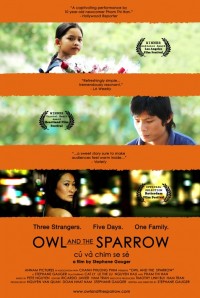 There’s a part of me that’s too tough, wise, and jaded for a film about a Vietnamese kid who runs away and must find a way to survive in Ho Chi Minh City. But there’s also a part of me that will always be touched by children and loneliness and getting torn from those you love, or brought finally together.
There’s a part of me that’s too tough, wise, and jaded for a film about a Vietnamese kid who runs away and must find a way to survive in Ho Chi Minh City. But there’s also a part of me that will always be touched by children and loneliness and getting torn from those you love, or brought finally together.
The tagline of The Owl and the Sparrow is “Three strangers. Five days.” The first of the three strangers is Thuy (Pham Thi Han), a young orphan who’s put to work in her uncle’s bamboo blinds factory. Since she’s ten years old, she doesn’t measure bamboo segments very well. Uncle reams her out and she decides, like any sensible kid, to run away. Except instead of making it to the end of the block and turning back like a normal child, she makes it all the way to the city. There she meets strangers number two and three — Lan (Cat Ly), a beautiful flight attendant, and Hai (Le The Lu), a zookeeper.
In five days she goes through three jobs and three homes, and gets by with the help and good advice of other street urchins. More realistically, this would have happened over the course of weeks or months. These are the types of people to whom nothing ever happens, ever. They can pass days and years without a change. And the film has the meditative pace typical of indie films. At any rate, if you visit Vietnam after watching The Owl and the Sparrow, you’ll look a little more closely at the rose-sellers and card-sellers, and have a more enriched sense of the possible stories behind them.
The film, with its obvious plot points, could easily have felt trite. But anything well acted and well written is engaging. I think this extends to all of film production and art in general — created with sincerity, it will be felt with sincerity. The only exceptions in this film, both included to bring the action to some sort of climax: a National Geographic-esque montage of Vietnamese children looking at you with their dark soulful eyes, and a scene of people running into each others’ arms at the airport.
To end on a good note — because it is a good film — there are touches of Asian culture that make the film true to life: little gifts, animal lovers, asking people if they’re married like you say how are you (somehow I associate that with Asians, especially Southeast Asians). Agrarian values, tensions between business and humanity. Sailor moon outfits, sweatshop, factory. It’s so rare to see these elements in your average American television show or movie, which is why it’s important to see it if it happens to play near you:
Los Angeles – at Laemle Sunset 5 on January 16
Orange County (the director Stephane Gauger’s hometown)- at Westminster 10 on January 16
San Jose– at Camara 12 on January 23








